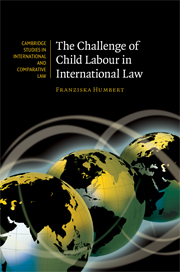Book contents
- Frontmatter
- Contents
- List of abbreviations
- Foreword
- Acknowledgements
- Introduction
- 1 The problem of child labour
- 2 The prohibition of child labour in international law
- 3 UN and ILO implementation mechanisms for the prohibition of child labour
- 4 Trade measures on child labour
- 5 Recommendations for an ILO–WTO enforcement regime
- Concluding summary
- Bibliography
- Index
- CAMBRIDGE STUDIES IN INTERNATIONAL AND COMPARATIVE LAW
4 - Trade measures on child labour
Published online by Cambridge University Press: 20 February 2010
- Frontmatter
- Contents
- List of abbreviations
- Foreword
- Acknowledgements
- Introduction
- 1 The problem of child labour
- 2 The prohibition of child labour in international law
- 3 UN and ILO implementation mechanisms for the prohibition of child labour
- 4 Trade measures on child labour
- 5 Recommendations for an ILO–WTO enforcement regime
- Concluding summary
- Bibliography
- Index
- CAMBRIDGE STUDIES IN INTERNATIONAL AND COMPARATIVE LAW
Summary
INTRODUCTION
History has shown that under certain conditions, trade measures can be effective means of advancing the cause of human rights. A famous example is the first successful consumer boycott when hundreds of thousands refused to buy sugar produced by slaves in the Caribbean in order to achieve the abolition of slavery 200 years ago. Today, many more examples of trade measures on human rights exist.
In order to find out whether trade measures should complement the existing ILO and UN enforcement systems regarding the prohibition of child labour, this chapter will examine so-called existing ‘social clauses’ in trade agreements, trade incentive regimes, unilateral legislation providing for trade measures as well as private sector action aimed at the eradication of child labour. The term ‘multilateral social clause’ relates to a clause that applies at a global in contrast to a regional level. Since to date, no specific multilateral social clause exists, the chapter will begin by analysing social clauses in regional and bilateral trade agreements.
SOCIAL CLAUSES IN REGIONAL AND BILATERAL TRADE AGREEMENTS
Introduction
Several regional trade agreements refer to labour standards. The North American Free Trade Agreement (NAFTA) provides for a side agreement on labour standards, the North American Agreement on Labor Cooperation (NAALC). Brazil, Argentina, Uruguay and Paraguay also included a declaration on social standards, the ‘Declaración Sociolaboral de 1998’ in their MERCOSUR.
Since 2000 however, there has been a proliferation of bilateral trade agreements concluded by the US incorporating labour standards as part of their foreign trade policy.
- Type
- Chapter
- Information
- The Challenge of Child Labour in International Law , pp. 195 - 375Publisher: Cambridge University PressPrint publication year: 2009



